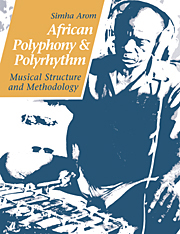Book contents
- Frontmatter
- Contents
- List of illustrations
- Foreword by György Ligeti
- Preface
- Acknowledgements
- BOOK I THE MUSIC OF THE CENTRAL AFRICAN REPUBLIC
- BOOK II AFRICAN POLYPHONIC MUSIC
- BOOK III TECHNICAL TOOLS: METHODS OF RECORDING POLYPHONIC MUSIC FOR TRANSCRIPTION
- BOOK IV THEORETICAL TOOLS
- BOOK V THE ORGANISATION OF TIME IN AFRICAN MUSIC
- BOOK VI STRUCTURAL PRINCIPLES AND THEIR APPLICATION
- 1 Typology
- 2 Analytical notions
- 3 Strict polyrhythmics
- 4 Polyrhythmics as a way to polyphony: Hocket
- 5 Polyphony produced by melodic instruments
- 6 The association of polyphony and polyrhythmics
- Conclusion
- Bibliography
3 - Strict polyrhythmics
Published online by Cambridge University Press: 27 January 2010
- Frontmatter
- Contents
- List of illustrations
- Foreword by György Ligeti
- Preface
- Acknowledgements
- BOOK I THE MUSIC OF THE CENTRAL AFRICAN REPUBLIC
- BOOK II AFRICAN POLYPHONIC MUSIC
- BOOK III TECHNICAL TOOLS: METHODS OF RECORDING POLYPHONIC MUSIC FOR TRANSCRIPTION
- BOOK IV THEORETICAL TOOLS
- BOOK V THE ORGANISATION OF TIME IN AFRICAN MUSIC
- BOOK VI STRUCTURAL PRINCIPLES AND THEIR APPLICATION
- 1 Typology
- 2 Analytical notions
- 3 Strict polyrhythmics
- 4 Polyrhythmics as a way to polyphony: Hocket
- 5 Polyphony produced by melodic instruments
- 6 The association of polyphony and polyrhythmics
- Conclusion
- Bibliography
Summary
PERIODICITY AND THE FUNDAMENTAL CHARACTERISTICS OF RHYTHM
Strict polyrhythmics consists of an ordered and coherent superposition of different rhythmic events. We must therefore carefully examine how its component elements are organised before we approach the concept itself.
Pure rhythmics
A clear initial distinction must be made between the rhythmic phenomena found in music where relative pitches form a scalar system (i.e., melodic music); and in music where the melodic parameter is neutralised, leaving only pure rhythmics. We wish to deal here with the latter case.
Pure rhythmics can be based on accentuation, on changing tone colour, or simply on contrasting durations. Pure rhythm can be produced in Africa, as elsewhere, by various sorts of musical instruments (in the main classifiable as idiophones or membranophones); however, parts of the human body may also be used, as for example, when people stamp their feet on the ground, clap their hands, and so on. Pure rhythmics is frequently not incompatible with the perception of melodic sequences resulting from the simultaneous use of diverse pitches and tone colours. There is, however, no immanent (i.e., cultural) basis for interpreting such sequences as melodic entities, because their constituent elements are not integrated into a preconceived system of relative pitch.
Fundamental characteristics
If one listens carefully to a Central African percussion ensemble, one will quickly perceive the fundamental characteristics prevailing in the rhythmics of this region:
– regular, stable movement, free of accelerando, rallentando, or rubato; the music is measured and contains strictly proportional durations.
– strict periodicity, evident from the predominance of uninterrupted repetitive formulae in which similar material reappears at regular intervals of time;
– formulae which are not completely identical; the repetitive system allows a certain degree of variability;
[…]
- Type
- Chapter
- Information
- African Polyphony and PolyrhythmMusical Structure and Methodology, pp. 229 - 306Publisher: Cambridge University PressPrint publication year: 1991



